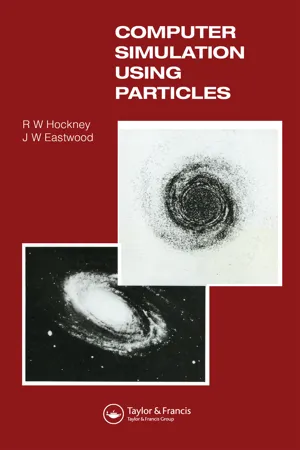
- 540 pages
- English
- ePUB (mobile friendly)
- Available on iOS & Android
Computer Simulation Using Particles
About this book
Computer simulation of systems has become an important tool in scientific research and engineering design, including the simulation of systems through the motion of their constituent particles. Important examples of this are the motion of stars in galaxies, ions in hot gas plasmas, electrons in semiconductor devices, and atoms in solids and liquids. The behavior of the system is studied by programming into the computer a model of the system and then performing experiments with this model. New scientific insight is obtained by observing such computer experiments, often for controlled conditions that are not accessible in the laboratory. Computer Simulation using Particles deals with the simulation of systems by following the motion of their constituent particles. This book provides an introduction to simulation using particles based on the NGP, CIC, and P3M algorithms and the programming principles that assist with the preparations of large simulation programs based on the OLYMPUS methodology. It also includes case study examples in the fields of astrophysics, plasmas, semiconductors, and ionic solids as well as more detailed mathematical treatment of the models, such as their errors, dispersion, and optimization.This resource will help you understand how engineering design can be assisted by the ability to predict performance using the computer model before embarking on costly and time-consuming manufacture.
Frequently asked questions
- Essential is ideal for learners and professionals who enjoy exploring a wide range of subjects. Access the Essential Library with 800,000+ trusted titles and best-sellers across business, personal growth, and the humanities. Includes unlimited reading time and Standard Read Aloud voice.
- Complete: Perfect for advanced learners and researchers needing full, unrestricted access. Unlock 1.4M+ books across hundreds of subjects, including academic and specialized titles. The Complete Plan also includes advanced features like Premium Read Aloud and Research Assistant.
Please note we cannot support devices running on iOS 13 and Android 7 or earlier. Learn more about using the app.
Information
CHAPTER
ONE
COMPUTER EXPERIMENTS USING PARTICLE MODELS
1-1 INTRODUCTION
Table of contents
- Cover
- Half Title
- Title Page
- Copyright Page
- Dedication
- Table of Contents
- Foreword
- Preface to the Paperback Edition
- Preface
- Chapter 1 Computer Experiments Using Particle Models
- Chapter 2 A One-Dimensional Plasma Model
- Chapter 3 The Simulation Program
- Chapter 4 Time Integration Schemes
- Chapter 5 The Particle-Mesh Force Calculation
- Chapter 6 The Solution of the Field Equations
- Chapter 7 Collisionless Particle Models
- Chapter 8 Particle-Particle-Particle-Mesh (P3M) Algorithms
- Chapter 9 Plasma Simulation
- Chapter 10 Semiconductor Device Simulation
- Chapter 11 Astrophysics
- Chapter 12 Solids, Liquids, and Phase Changes
- Appendix A Fourier Transforms, Fourier Series, and Finite Fourier Transforms
- Bibliography
- Index